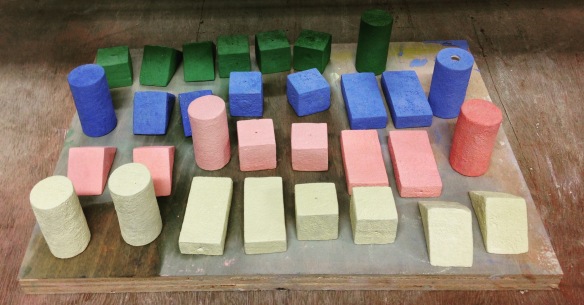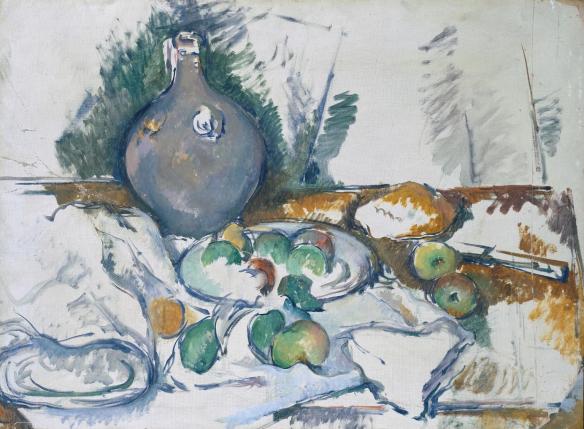
This is the same slip used, but fired at different temperatures…
(from left) 1220 degrees
1140 degrees
1100 degrees
As you can see, they have decreased in size as the properties have fused and vitrified. There is a nice waxy finish on the 1220 firing, and I would consider this a success! One thing I will say is that I wish to spray gun the slip onto my actual pieces. Brushing on the slip isn’t doesn’t produce the texture I want. I want the pieces to be (specifically for the Ken Stradling collection) tactile, and the texture just isn’t there with brush on, it looks too similar to the wooden blocks I casted!
After speaking to Matt, he confirmed by doubts of using a spray gun to decorate the small building blocks: the pressure from the air would knock them over and they would be very fiddly to spray, probably catching more water than the actual slip. He suggested I use a latex make up sponge instead and dab the slip onto my blocks.

This was taken yesterday before they went into a 1220 firing! They are still in the kiln as I type, cooling down. I am going into uni today to check up on them!!! You can see they have a really nice texture, from the songs I used to decorate them. Ahhh I can’t wait to see them!
For my summative assessment I want to make variantly textured building blocks, some sanded down and ultra smooth, and others bumpy. I think 3 different textures (including my ones above) would be good, and something achievable with the time I have left before we are assessed.

Interestingly, I think this texture would be a fun one to incorporate, an example of serendipity. I coated an already fired vitreous slip coated cylinder in my salmon pink glaze and then putting it into a 1220 firing. Obviously this red glaze was intended for a 1100 firing, so it blistered from the the heat, but it is certainly a bumpy texture I could use!
I wanted to do a bit of research around the chemistry of vitreous slips, mainly fascination, it really is half way between bisque fired and glazed; so I did a little research online and looked back at my first year notes from when Duncan gave us lectures on the properties of clay, from the ground up.
A flux (zinc or copper to name a few) lowers the melting point of clay, meaning that glazes and slips will vitrify (melt and achieve that glassy effect) at a lower temperature than without the flux being present. Refractory materials, such as kaolin, ball clay and flint, do the exact opposite; that being that if for example, a decorative slip matures at a much cooler temperature than the clay is has been coated on, it may require some ball clay added to the mixture so that it needs more heat (which is what the clay underneath would require in this scenario) for it to fuse.
It’s worth noting that some elements behave differently depending on what kiln firing it is. Iron, a refractory material in oxidation, is a strong flux in reduction.
Understanding the science behind clay really aids the making process. If I knew that I needed to fire my pieces at a higher temperature, I wouldn’t have had needed to book so many kilns and so as many firings! But then again, it’s second year, I have time to learn these things in place for my final year of my degree.




















































